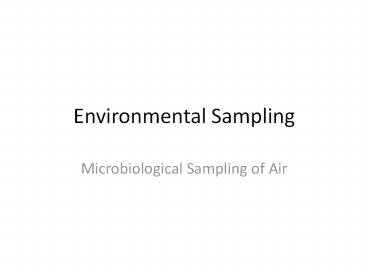Environmental Sampling - PowerPoint PPT Presentation
Title:
Environmental Sampling
Description:
Environmental Sampling Microbiological Sampling of Air Environmental Sampling Environmental microbiology is not clinical microbiology Sampling is supported by ... – PowerPoint PPT presentation
Number of Views:181
Avg rating:3.0/5.0
Title: Environmental Sampling
1
Environmental Sampling
- Microbiological Sampling of Air
2
Environmental Sampling
- Environmental microbiology is not clinical
microbiology - Sampling is supported by epidemiologic assessment
- Random, undirected sampling is not recommended
- Sampling requires a protocol for sampling and
culturing, analysis of results, and action based
on the interpretation of results
3
Environmental Sampling
- Suggested uses
- Support for outbreak investigation
- Research in environmental infection control
- Monitor a potentially hazardous situation
- Evaluate a change in environmental infection
control for quality assurance purposes - Perform periodic regular maintenance of equipment
(AC systems) - Legal issues
4
Environmental Sampling
- Expensive and time-consuming subject to many
variables in protocol, analysis, and
interpretation - Difficult and problematic
- No baselines, no acceptable ranges
- Few protocols for conducting planned, directed
environmental studies in health care settings. - The investigator is required to minimize false
negatives and false positives.
5
Why do Air Sampling?
- Verification of ventilation and cleanliness
- Establish baseline data
- Post infection evaluation (outbreak
investigation) - Rule out ventilation as a source
- Discover source of infectious fungi (reservoir)
- Construction, renovation, repair of certain
buildings such as hospitals - Employee complaints
6
Microorganisms of the air
- Important Facts
- Air has no indigenous flora
- Organisms are found temporarily suspended in air
or carried on dust particles or droplets - Air is not sterile
- Air does not support the growth of organisms
7
Before You Do Microbiological Air Sampling
- Define your objective and analytical approach
- Qualitative vs. quantitative
- Compare indoor results to counts from outdoor
air - Fully describe the circumstances in the area
where sampling is occurring - High volume sampling most efficient
8
Air Sampling
- To determine bacteria and fungi identities and
concentration in biological aerosols - Major methods
- Impingement in liquids
- Impaction on solid surfaces
- Sedimentation (e.g., settle plates)
- Requires an understanding of what is being
measured and a full description of the
circumstances during sampling
9
Compare and Contrast the Main Air Sampling Methods
Method Principle Suitable for Measuring Collection Media or Surface Points to Consider
Impingement in liquids Air drawn in through small jet, directed against liquid surface Viable microorganisms, water aerosols Buffered gelatin, peptone, nutrient broth, tryptose saline Used for Legionella spp. sampling
Impaction on solid surface Air drawn into sampler, particles deposited on dry surface Viable particles, viable microorganisms Dry surfaces, coated surfaces, agar Used for bacteria and fungal agent sampling high volumes can be sampled
Sedimentation (settle plates) Particles and microorganisms settle via gravity Viable particles, viable microorganisms Nutrient agars in plates or slides Simple, best suited for qualitative sampling not used for fungal spores
10
Types of Air Samplers
A.
B.
C.
A. Impactor sampler B. Glass impinger
sampler C. Sieve impactor sampler
11
Unresolved Issues and Microbiologic Air Sampling
- Unknown incubation period
- Infectious dose for Aspergillus spp. is unknown
- Lack of standard sampling protocols
- No standards or action levels for results
- Variability and sensitivity of sampling devices
- Lack of details re sampling makes comparison of
results with other outbreaks difficult - Lack of correlation between fungal strains in
clinical specimens and those found in the
environment
12
How to Sample for Viable Mold and Bacteria
- Non-viable spore
- trap sampler
- Air sampling cassette (Auto sampler)
- High volume vacuum pump
- Viable Sampling
- Active
- Surface Air Sampler (SAS)
- Passive
- Settle Plates
SAS
13
Practical work
- Each student will have 2 PCA plates, and should
perform gravity method - Expose one plate indoor ,and one outdoor for 1
hour .( Care taken to choose different areas) - Properly label your plates ( indoor or outdoor ,
name of place, time, duration, student name) - Bring to lab next day. Incubate at 37c for 48
hours, then read results with instructor.
14
Results
- It is important to compare No and type of
organisms grown on plates between indoor and
outdoor. - A lot of bacteria such as colored Micrococci,
Actinomycetes, Bacillus , Pseudomonas , etc. - A lot of fungi ,molds and yeast.
- Usually No of outdoor orgs is higher than indoor
No. - If a predominant organism exist , this is not
normal especially for indoor places. - High indoor No's are not normal in certain rooms.
15
General control of air borne diseases
- Good ventilation( dilutes organisms)
- Avoid overcrowding especially in closed places
- Isolation of patients with serious respiratory
infections - Wearing masks
- Spacing of beds or desks
- Disinfect air ( HEPA Filters, UV hoods)
- Vaccination
16
Agar plates exposed to Air
17
Actinomycetes on Agar plates
18
Actinomycetes gram stained smear Gram ve
branching rods
19
Yeast stained smear































